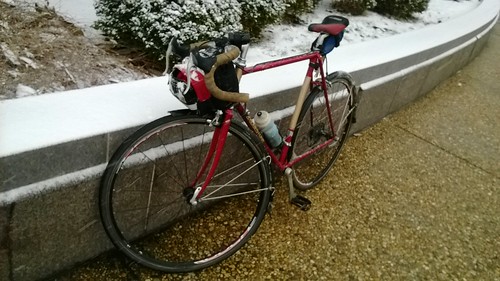
The perfect commuter bike?
In 2011 I purchased the frame, including fork, of this 1982 Bridgestone Sirius road bike. At the time it was the "top of the line" road bike sold by Bridgestone in the U.S. I bought it used on eBay for a little over $100 including the shipping, which was a good price. The frame appeared never to have had components attached to it or to have been used - it was, in effect, a 30 year old unused bike. I attached a mix of components (many not "period correct" alas) and commenced using this as my main commuter to and from work, about 19 miles round trip.

Winter cycling shoe (boot) cleated in to pedal and amount of overlap with front wheel and fender
I would suggest that any bike used for commuting represents a series of compromises, starting with how much money you are willing to spend versus your desire for certain features. (The perhaps trite phrase for bicycle choice generally is, "strong, light, cheap - pick two.") This Bridgestone is relatively light given that even after I bought components and assembled it all, it was only around $500. I chose to stick with wheels and tires that are relatively narrow compared to what is popular now. Most people are not crazy about downtube shifters but they are extremely low maintenance. I also like the dual pivot brakes which are more modern than what the bike would have had when originally sold in 1982 but not as good at stopping as the disk brakes I had on the bike I used before this - but I got tired of the maintenance associated with disk brakes. The dual pivot rim brakes are predictable for both maintenance an performance.
One problem however that I simply live with is the toe overlap. I fitted the bike with fenders, which makes the wheel extend back towards the pedals that much further, but in winter the problem is more with the bike boots I wear and where I have the cleats fitted on the bottom of them, which means that the front ends of the shoes are well in the travel path of the front wheel when steering. The crank arms are relatively short at 170 mm.
As it turns out in practice, awareness of this problem is the main thing - I haven't had a problem with this in years. And as it happens, as a practical matter, I hardly ever steer hard enough left or right that it matters, which may seem surprising but seems to be how it is. I ride up Capitol Hill on the Capitol grounds on a roadway where I zig-zag my way up (to decrease how steep it is for the ride) and even that at a relatively slow speed doesn't require a particularly tight turn, or enough that this overlap matters.
So if this is all that keeps this from being the perfect bike, I can live with it.
No comments:
Post a Comment